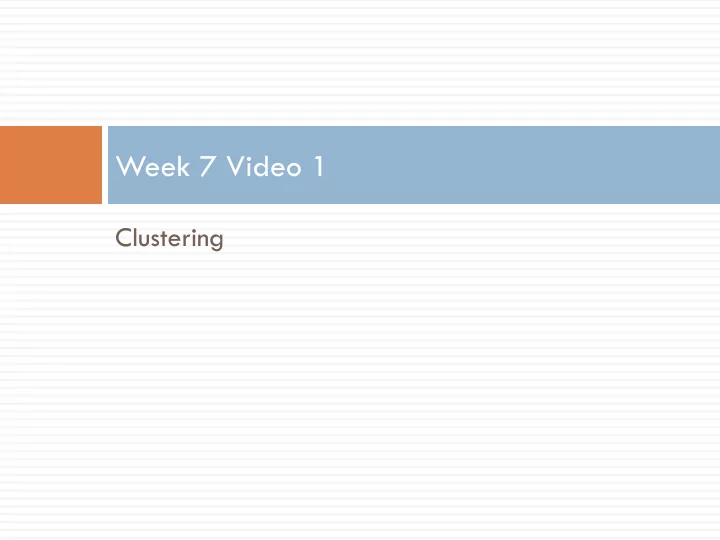

Week 7 Video 1 Clustering
Clustering ¨ A type of Structure Discovery algorithm ¨ This type of method is also referred to as Dimensionality Reduction , based on a common application
Clustering ¨ You have a large number of data points ¨ You want to find what structure there is among the data points ¨ You don’t know anything a priori about the structure ¨ Clustering tries to find data points that “group together”
Trivial Example ¨ Let’s say your data has two variables ¤ Probability the student knows the skill from BKT (Pknow) ¤ Unitized Time ¨ Note: clustering works for (and is effective in) large feature spaces
+3 time 0 -3 0 1 pknow
k-Means Clustering Algorithm +3 time 0 -3 0 1 pknow
Not the only clustering algorithm ¨ Just the simplest ¨ We’ll discuss fancier ones as the week goes on
How did we get these clusters? ¨ First we decided how many clusters we wanted, 5 ¤ How did we do that? More on this in the next lecture ¨ We picked starting values for the “centroids” of the clusters… ¤ Usually chosen randomly ¤ Sometimes there are good reasons to start with specific initial values…
+3 time 0 -3 0 1 pknow
Then… ¨ We classify every point as to which centroid it’s closest to ¤ This defines the clusters ¤ Typically visualized as a voronoi diagram
+3 time 0 -3 0 1 pknow
Then… ¨ We re-fit the centroids as the center of the points in each cluster
+3 time 0 -3 0 1 pknow
Then… ¨ Repeat the process until the centroids stop moving ¨ “Convergence”
+3 time 0 -3 0 1 pknow
+3 time 0 -3 0 1 pknow
+3 time 0 -3 0 1 pknow
+3 time 0 -3 0 1 pknow
+3 time 0 -3 0 1 pknow
Note that there are some outliers +3 time 0 -3 0 1 pknow
What if we start with these points? +3 time 0 -3 0 1 pknow
Not very good clusters +3 time 0 -3 0 1 pknow
What happens? ¨ What happens if your starting points are in strange places? ¨ Not trivial to avoid, considering the full span of possible data distributions
One Solution ¨ Run several times, involving different starting points ¨ cf. Conati & Amershi (2009)
Exercises ¨ Take the following examples ¨ (The slides will be available in course materials so you can work through them) ¨ And execute k-means for them ¨ Do this by hand… ¨ Focus on getting the concept rather than the exact right answer… ¨ (Solutions are by hand rather than actually using code, and are not guaranteed to be perfect)
Exercise 7-1-1 +3 time 0 -3 0 1 pknow
Pause Here with In-Video Quiz ¨ Do this yourself if you want to ¨ Only quiz option: go ahead
Solution Step 1 +3 time 0 -3 0 1 pknow
Solution Step 2 +3 time 0 -3 0 1 pknow
Solution Step 3 +3 time 0 -3 0 1 pknow
Solution Step 4 +3 time 0 -3 0 1 pknow
Solution Step 5 +3 time 0 -3 0 1 pknow
No points switched -- convergence +3 time 0 -3 0 1 pknow
Notes ¨ K-Means did pretty reasonable here
Exercise 7-1-2 +3 time 0 -3 0 1 pknow
Pause Here with In-Video Quiz ¨ Do this yourself if you want to ¨ Only quiz option: go ahead
Solution Step 1 +3 time 0 -3 0 1 pknow
Solution Step 2 +3 time 0 -3 0 1 pknow
Solution Step 3 +3 time 0 -3 0 1 pknow
Solution Step 4 +3 time 0 -3 0 1 pknow
Solution Step 5 +3 time 0 -3 0 1 pknow
Notes ¨ The three clusters in the same data lump might move around for a little while ¨ But really, what we have here is one cluster and two outliers… ¨ k should be 3 rather than 5 ¤ See next lecture to learn more
Exercise 7-1-3 +3 time 0 -3 0 1 pknow
Pause Here with In-Video Quiz ¨ Do this yourself if you want to ¨ Only quiz option: go ahead
Solution +3 time 0 -3 0 1 pknow
Notes ¨ The bottom-right cluster is actually empty! ¨ There was never a point where that centroid was actually closest to any point
Exercise 7-1-4 +3 time 0 -3 0 1 pknow
Pause Here with In-Video Quiz ¨ Do this yourself if you want to ¨ Only quiz option: go ahead
Solution Step 1 +3 time 0 -3 0 1 pknow
Solution Step 2 +3 time 0 -3 0 1 pknow
Solution Step 3 +3 time 0 -3 0 1 pknow
Solution Step 4 +3 time 0 -3 0 1 pknow
Solution Step 5 +3 time 0 -3 0 1 pknow
Solution Step 6 +3 time 0 -3 0 1 pknow
Solution Step 7 +3 time 0 -3 0 1 pknow
Approximate Solution +3 time 0 -3 0 1 pknow
Notes ¨ Kind of a weird outcome ¨ By unlucky initial positioning ¤ One data lump at left became three clusters ¤ Two clearly distinct data lumps at right became one cluster
Exercise 7-1-5 +3 time 0 -3 0 1 pknow
Pause Here with In-Video Quiz ¨ Do this yourself if you want to ¨ Only quiz option: go ahead
Exercise 7-1-5 +3 time 0 -3 0 1 pknow
Notes ¨ That actually kind of came out ok…
As you can see ¨ A lot depends on initial positioning ¨ And on the number of clusters ¨ How do you pick which final position and number of clusters to go with?
Next lecture ¨ Clustering – Validation and Selection of k
Recommend
More recommend